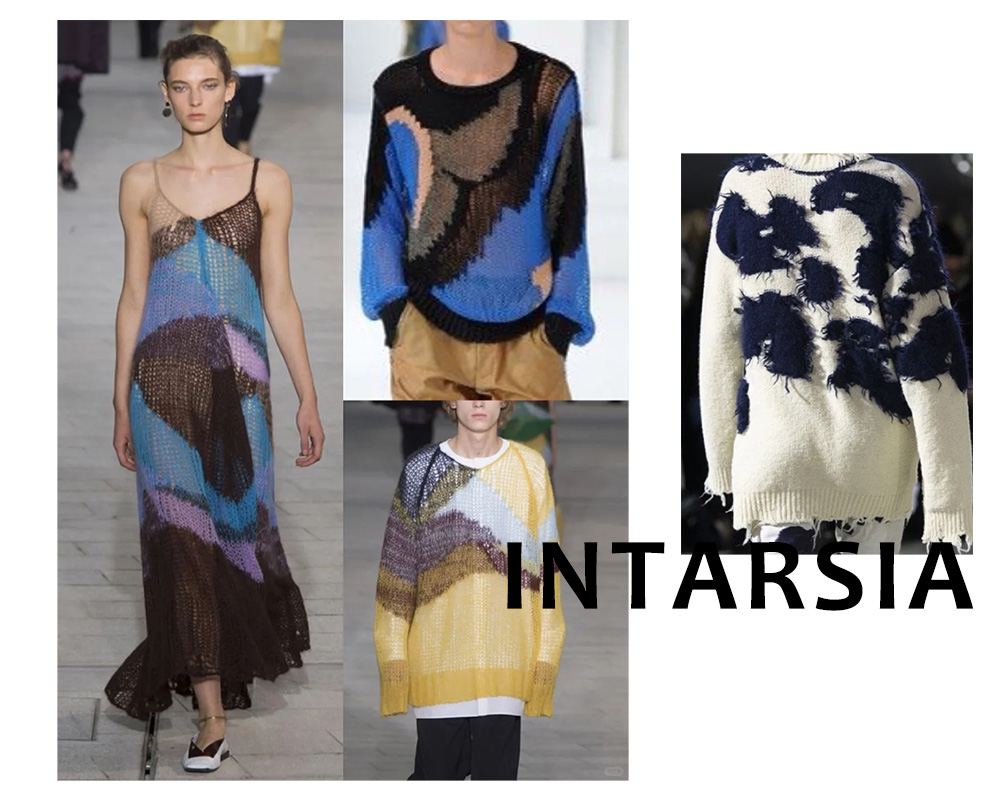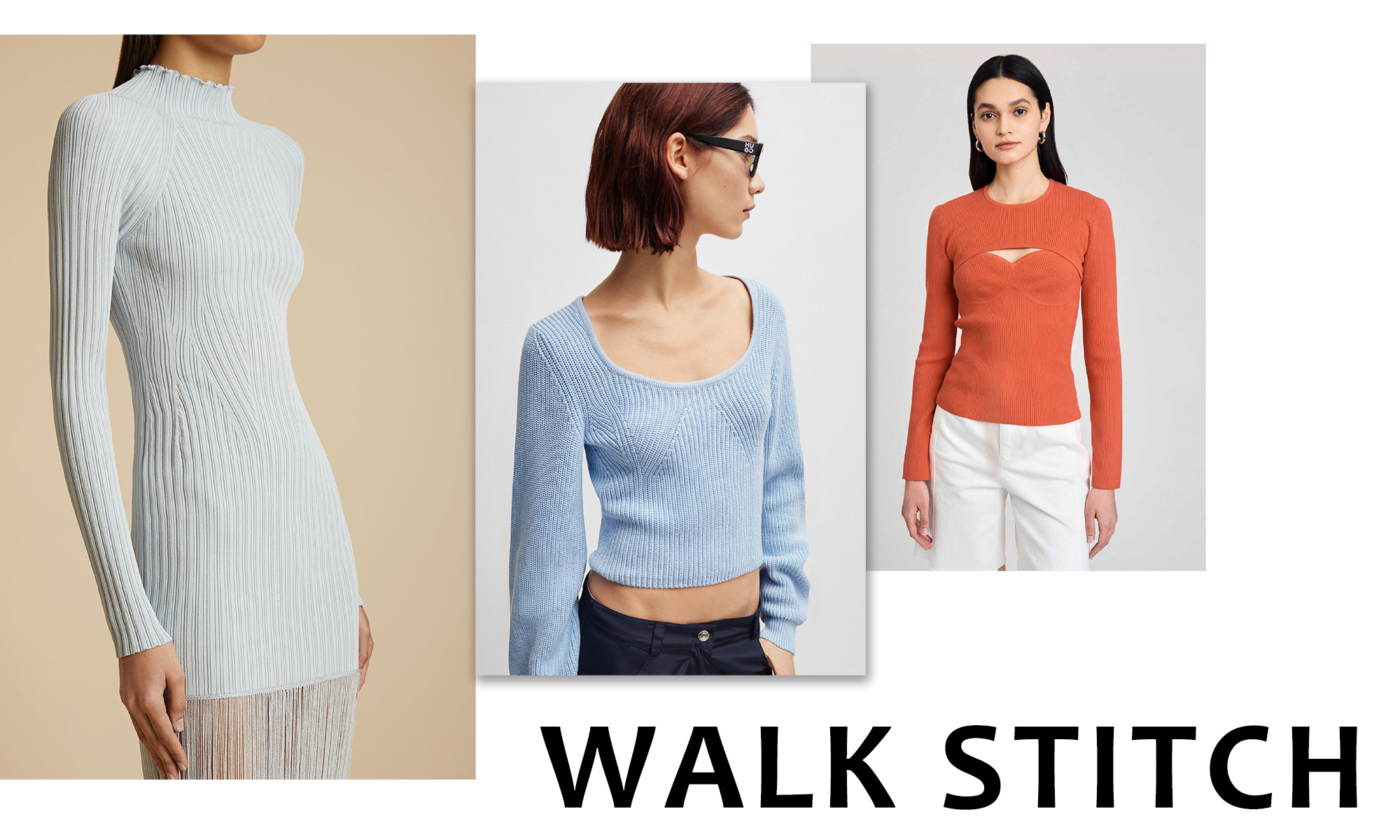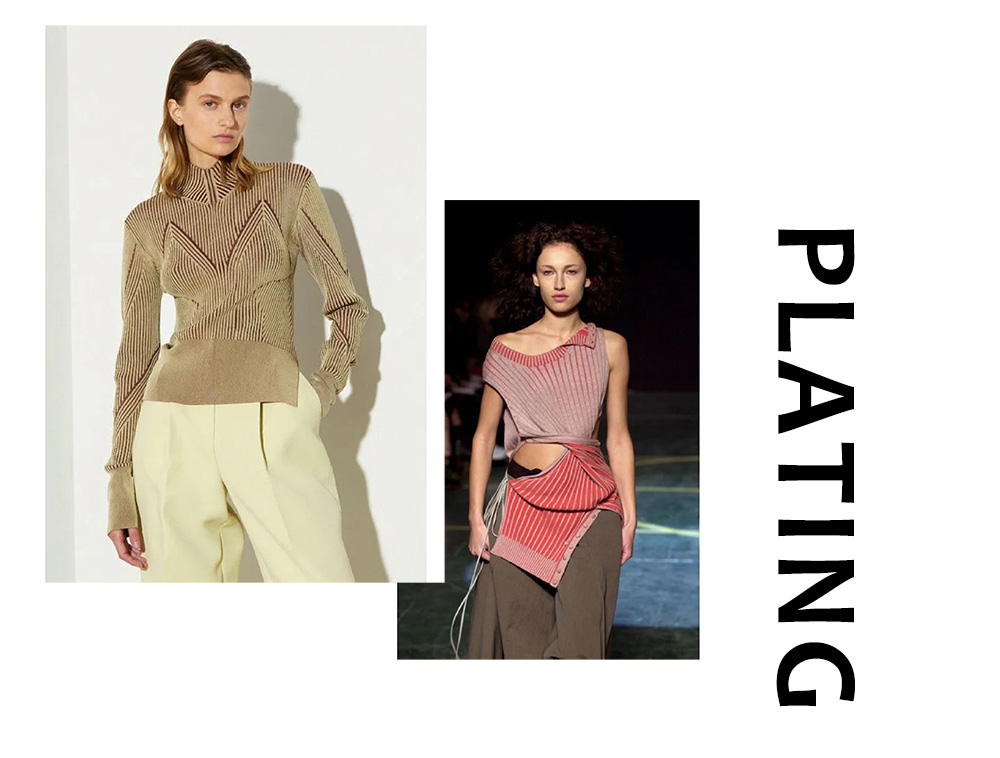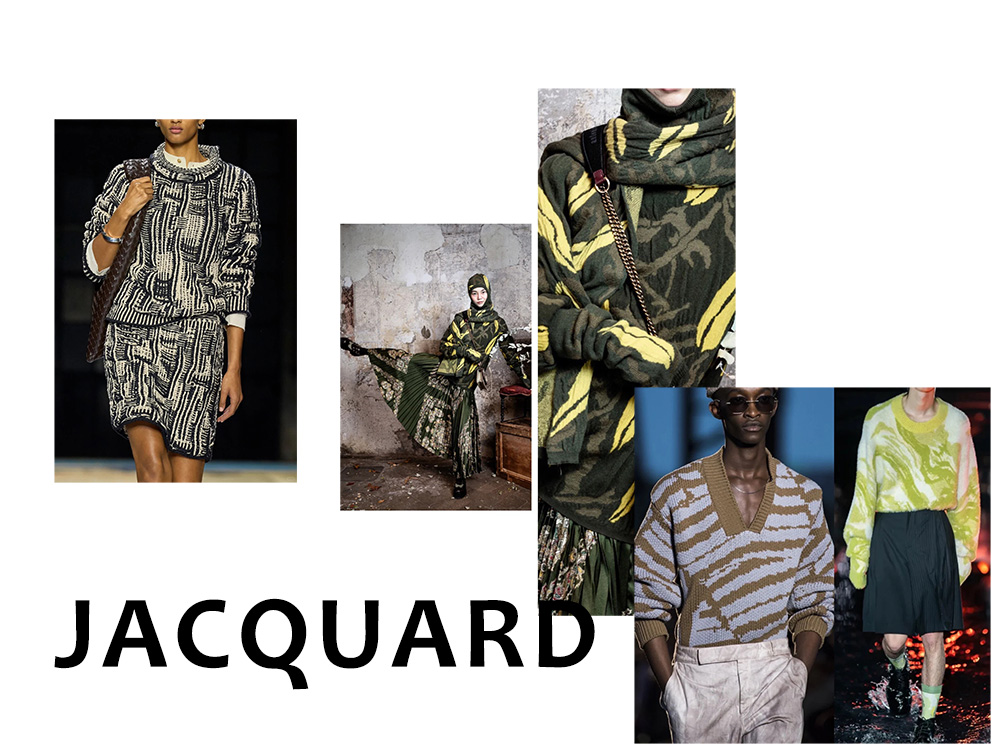Following Part 1’s exploration of texture’s power and popular stitch patterns, let’s delve deeper into a new selection of techniques. This expanded knowledge base equips you to craft even more captivating and diverse knitwear collections that resonate with your target audience.
Beyond the Basics: Unveiling a Spectrum of Textures
This section delves into a variety of stitch patterns, each offering unique design possibilities. Consider these techniques as potential tools to elevate your brand’s aesthetic appeal and functionality:
Intarsia: A Tapestry of Color

Intarsia is a captivating technique that allows for the creation of intricate, multi-colored designs within a knitted fabric. This method involves knitting with multiple colors simultaneously, resulting in a vibrant and visually striking piece.
Key Characteristics:
- Color Precision: Intarsia provides complete control over color placement, enabling the creation of detailed patterns and motifs.
- Design Versatility: This technique offers endless possibilities for graphic designs, landscapes, portraits, and abstract patterns.
- Textural Contrast: The interplay of different colors and textures can create a dynamic and visually appealing fabric.
- Time and Skill Intensive: Intarsia requires careful planning and execution, making it a technique suitable for experienced knitters.
Ideal Applications:
- Statement Pieces: Intarsia is perfect for creating eye-catching sweaters, cardigans, and accessories that make a bold fashion statement.
- Children’s Wear: Intarsia can be used to create playful and whimsical designs for children’s clothing featuring characters, animals, or abstract patterns.
- Home Decor: Intarsia is ideal for adding a touch of personality to blankets, pillows, and other home textiles.
-
Crochet Stitch: A Fusion of Craftsmanship and Design

Crochet stitch offers a unique approach to texture, combining the artistry of knitting with the versatility of crochet. This technique introduces a playful and unexpected element to knitwear, allowing for a wider range of design possibilities.
Key Characteristics:
- Textural Contrast: The interplay between knit and crochet stitches creates a visually captivating and tactile fabric.
- Design Versatility: Crochet elements can be incorporated seamlessly into knitwear, offering endless possibilities for creative expression.
- Retro Appeal: Crochet evokes a sense of nostalgia and handmade craftsmanship, adding a vintage charm to contemporary designs.
- Three-Dimensional Effects: Crochet techniques can be used to create intricate, hollow designs, adding depth and dimension to knitwear.
Ideal Applications:
- ResortCollections: Crochet motifs and embellishments can evoke a nostalgic, handcrafted feel, perfect for holiday
- Textured Accents: Incorporate crochet elements as trims, collars, or pockets to add a unique touch to knitwear pieces.
- Contemporary Design: Experiment with combining crochet and knit stitches to create modern and innovative designs that appeal to fashion-forward consumers.
Full Needle Rib Stitch: Bold and Graphic Statements

Full needle stitch offers a unique approach to knitwear construction by creating a fabric that is similar to 1*1 rib but thicker and smoother. This technique results in a garment that is both highly elastic and exceptionally warm.
Key Characteristics:
- Thickness and Warmth: Full-needled rib stitch produces a significantly thicker fabric compared to 1*1 Rib stitches, offering exceptional warmth and insulation.
- Double-Sided: The fabric exhibits the same structure on both sides, eliminating the need for separate lining or finishing techniques.
- Warmth: Due to its double-layered nature and tight structure, it offers good insulation.
- Highly elastic: This structure provides exceptional stretch and recovery
Ideal Applications:
- Sweater Bodies: The warmth and structure of full stitch make it an excellent choice for sweater bodies, particularly in colder climates.
- Collars and Cuffs: Full stitch can be used to create substantial and warm collars and cuffs for sweaters and jackets.
- Plackets and Pockets: The thickness and stability of full needle stitch make it suitable for creating robust plackets and pockets.
Half Milano Rib Stitch: Refined Ribbing for Elevated Aesthetics
Half Milano rib stitch is a knit fabric construction characterized by its distinctive combination of full needle rib and jersey elements. This structure imparts unique properties to the resulting textile.
Key Characteristics:
- Structural Composition: A balanced interplay of rib and jersey stitch formations.
- Hand Feel: Typically soft and supple due to the incorporation of jersey elements.
- Elasticity: Exhibits moderate stretch, providing comfort and flexibility.
- Visual Appearance: Presents a distinct face and reverse side, offering visual interest.
- Density: While generally thicker than Jersey, it will vary depending on yarn choice and stitch gauge, influencing fabric weight and drape.
Ideal Applications:
The versatile nature of Half Milano rib stitch renders it suitable for a wide range of apparel applications, including:
- Sweater and Cardigan Construction: Provides a balanced combination of warmth, comfort, and style.
- Jacket Fabrication: Offers a contemporary aesthetic while maintaining functional properties.
- General Knitwear: Applicable to various garment types where a blend of elasticity and texture is desired.
Full Milano Rib Stitch: Rich and Textured for a Luxurious Feel
Full Milano rib stitch is a knit fabric structure renowned for its luxurious feel, durability, and distinctive appearance.
Key Characteristics:
- Physical Properties: Thick, crisp, and possessing low lateral stretchability.
- Stability: Exhibits excellent dimensional stability with subtle, hidden lateral stripes on the fabric’s surface.
- Visual Appearance: Presents an identical look on both the front and back of the fabric.
Ideal Applications:
Due to its unique properties, Full Milano rib stitch is primarily used in:
- High-end fashion apparel: Luxury garments that demand a premium feel and appearance.
- Outerwear: Jackets and coats that require durability and shape retention.
- Tailored garments: Suits, blazers, and trousers where structure and elegance are essential.
The substantial nature and dimensional stability of Full Milano rib stitch make it an ideal choice for garments that require a refined and luxurious aesthetic.
Walk Stitch: A Delicate Dance for Subtle Intrigue

Walk stitch is a knit fabric structure characterized by its distinct appearance and properties. It’s created by alternating rows of knit and purl stitches, with a consistent offset between the stitches on each row. This stitch creates a subtle, wave-like texture on the knitted fabric. This delicate pattern adds a touch of visual intrigue without overwhelming the overall design, making it a versatile choice for a variety of knitwear styles.
Stoffeigenschaften:
- Visual Appearance: A distinctive diagonal pattern created by the offset stitches.
- Elasticity: Moderate stretch due to the combination of knit and purl stitches.
- Thickness: Generally medium weight, providing a balance of warmth and breathability.
- Hand Feel: Soft and pliable, offering comfort to the wearer.
Applications:
Walk stitch is commonly used in:
- Sweaters
- Cardigans
- Scarves
- Other knitwear itemswhere a visual interest and comfortable fit are desired.
Plating Stitch: Double the Warmth for CreativeAppeal

Plating is a knitting technique that involves interlacing two or more yarns to create a distinctive fabric structure. It’s often used to achieve color effects, texture, and increased fabric weight.
Fabric Characteristics:
- Visual Appearance: Can create a variety of patterns and textures depending on the yarn colors and the plating technique used. If knitted with two contrasting colors of yarn, the fabric will have a special pattern effect.
- Weight: Generally heavier than fabrics made with a single yarn due to the additional yarn.
- Texture: Can range from smooth to textured depending on the plating pattern.
- Elasticity: Depends on the specific yarn used and the plating technique, but generally less elastic than jersey knit.
Applications:
- Fashion apparel: Used to create unique and visually appealing garments.
- Home textiles: Blankets, throws, and other home decor items.
- Accessories: Scarves, hats, and other accessories can benefit from the added texture and warmth provided by plating.
Plating is a versatile technique that allows for a wide range of creative possibilities in knit fabric design.
JacquardStitch: Elevating Textiles with Intricate Patterns

Jacquard is a versatile textile technique that employs multiple colors of yarn to create intricate patterns. Its classification system categorizes fabrics based on construction and aesthetic attributes.
- Ladder Jacquard: This method incorporates supporting yarns to maintain fabric integrity, preventing distortion of the floating color threads. There are floating lines, which are often uneven
- TubularJacquard: Characterized by a double-layered construction, Tubular Jacquard offers substantial weight and a rich, textured appearance. The interplay of yarn layers creates a depth and complexity not found in other jacquard types. Surface irregularities, such as wrinkles and ridges, are inherent to this stitch. The color is richer than that of Birdseye Jacquard.
- Birdseye Jacquard: Known for its clear pattern, Birdseye Jacquard is the most commonly used double-sided jacquard pattern, The front pattern of this stitche is clear, and the back is like sesame dots, suitable for most patterns that only make 3-4 colors.
Each classification offers unique visual and tactile qualities, providing designers with a diverse range of options to suit various aesthetic and functional requirements. The choice of jacquard type significantly impacts the overall character of a textile, from its drape and hand feel to its visual impact.
Abschluss
This exploration of knit stitch patterns has only scratched the surface of the vast possibilities available to elevate your custom knitwear designs. By mastering texture, you can create captivating collections that resonate with your target audience and solidify your brand’s identity.
To truly harness the potential of texture, consider these essential tips:
- Source Inspiration: Look beyond traditional fashion sources for inspiration. Architectural patterns, natural elements, and even art movements can spark unique design ideas that translate beautifully into textured knitwear.
- Sample Extensively: Before incorporating a new stitch pattern into a full garment, create swatches to test drape, texture, and yarn compatibility. This allows for design refinement and avoids costly mistakes during production.
- Collaborate with Knitwear Experts: Partnering with experienced knitters allows you to leverage their technical expertise and gain valuable insights into the practical application of different stitch patterns. Our team of experts is ready to assist you in bringing your creative vision to life. Contact us today to discuss your project and explore how we can help you achieve your design goals.
The world of knit stitch patterns is a treasure trove of possibilities, offering endless opportunities to elevate your designs. From the classic elegance of rib stitch to the intricate beauty of jacquard, texture can transform a garment from ordinary to extraordinary. Embrace the challenge, explore new frontiers, and let texture be your signature design element.

 English
English Deutsch
Deutsch Français
Français Italiano
Italiano Español
Español Русский
Русский Polski
Polski Nederlands
Nederlands Svenska
Svenska

